125 years ago today, President William McKinley signed into law a bill creating Mount Rainier National Park, the fifth in the nation, in order to protect what John Muir described as some of the finest alpine meadows he ever saw, enveloping the slopes of an extinct stratovolcano that happens to be the highest peak in the lower 48 at 14,410-foot (4,390 meters) in height. READ more about the park and peak… (1899)

Ninety-seven percent of the park is preserved as wilderness under the National Wilderness Preservation System as Mount Rainier Wilderness, a designation it received in 1988. The name of the mountain itself in Lushootseed is “Tacoma”, the same as a nearby city in the Seattle metro area.
The trip to Mount Rainier had played a role in reinvigorating Muir and convincing him to rededicate his life to the preservation of nature as national parks. At the time national forests, called forest reserves at first, were being created throughout the American West, under the utilitarian “conservation-through-use” view of Gifford Pinchot. Muir came to be known as a “preservationist”. He wanted nature preserved under the more protected status of national parks.
When the Pacific Forest Reserve was created in 1893, Muir quickly persuaded the newly formed Sierra Club to support a movement to protect Rainier as a national park. Other groups soon joined, such as the National Geographic Society and scientific associations wanting Mount Rainier preserved as a place to study volcanism and glaciology. Commercial leaders in Tacoma and Seattle were also in support, as was the Northern Pacific Railway. The effort lasted over five years and involved six different attempts to push a bill through Congress.
MORE Good News on this Date:
- The US Congress prohibited the importation of slaves (1807)
- Russian serfdom was abolished by Alexander II (1861)
- Constantinople Convention was signed, giving free maritime passage through the Suez Canal during war and peace (1888)
- Dr. Seuss was born—the author and cartoonist known for his poetic writing and illustration of more than 60 of the world’s best-selling children’s books in 20 languages (1904)
- Miles Davis held the first recording session for his LP, Kind of Blue, with saxophonist John Coltrane in New York City (1959)
- The movie King Kong premiered in New York City (1933)
- Morocco declared independence from France (1956); Rhodesia from Britain (1970)
- CDs and Compact Disc players were first released in the U.S. and Europe, making playing LPs easier and virtually eliminating skips and scratchy sounds (1983)
- Armenia, Azerbaijan, Kazakhstan, Kyrgyzstan, Moldova, San Marino, Tajikistan, Turkmenistan, and Uzbekistan joined the United Nations (1992)
62 years ago today, Wilt Chamberlain took to the court for the Philadelphia Warriors against the New York Knick in the Hershey Sports Arena, without a single member of the televised press in attendance. He went on to score the only 100-point game ever by any player in the NBA. He set five other records that game, including most free throws completed. The match was not televised, and no New York press were at the game. Only radio from the fourth quarter has been recovered. LISTEN to the moment when he scored 100… (1962)
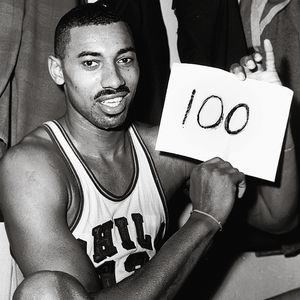
By the end of the first quarter, Chamberlain had already scored 23 points, including all 9 of his free throws. In a strange portent, a Knicks player who became frustrated for what he saw as a number of soft fouls given, told the referee “Well, why don’t you just give the guy a hundred now and we’ll all go home!” By halftime, Wilt had made 41 points, and later explained “I often came into the locker room with 30 or 35 points, therefore, 41 points was not a big deal”
Then in his third season with the team, Chamberlain had already made scoring records in his previous two, and the Warrior’s new coach had started the campaign vowing to get the ball to Chamberlain “two-thirds of the time.” It was decided in the dressing room that they would go out in the second half and “see how many he can get,” a tactic which proved remarkably successful, as even though the Knicks essentially began triple-teaming the big center, he had scored 69 at the end of the third.
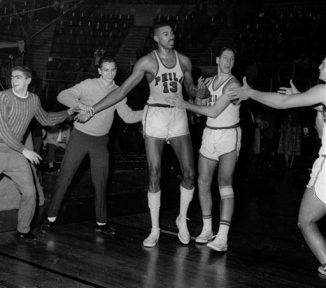
In the fourth quarter, Dave Zinkoff, the public address announcer, began announcing Chamberlain’s point total after each of his baskets, and the crowd was getting increasingly excited. The team’s moves degenerated to giving the ball to Chamberlain and then waiting to see what happened. With six minutes remaining, the Knicks began intentionally fouling any Warrior except Chamberlain, keeping the ball out of the center’s hands. But nothing, allegedly, could stop him. At 2:12 remaining, he scored 96; at 1:19, 98, and with 46 seconds left, he beat all five Knicks players to dunk home his century. The arena exploded in a frenzy and over 200 spectators stormed the floor, wanting to touch the hero of the night. Folklore says the game was never even finished, and that the ref called time then and there.
In 2016, the extant fourth-quarter audio recording of the 100-point game was added to the National Recording Registry for its “cultural, artistic and/or historical significance to American society and the nation’s aural legacy.”
233 years ago today, inventor Claude Chappe used the first optical telegraph to send a message over a long distance, slashing the time needed to transmit information by horseback. He sent the signals to his brother ten miles away, who discerned the message through a telescope: “Si vous reussissez, vous serez bientôt couvert de gloire.” (If you succeed, you will soon bask in glory.)
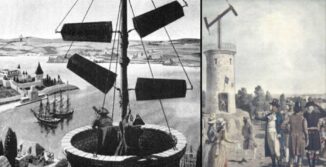 The successful proof-of-concept led to the first line of semaphore relay stations between Paris and Lille, a distance of 143 miles (230 km). A single symbol of any message would pass through 15 stations in only nine minutes. He and his four brothers also implemented a system across France, using telescopes and semaphore machines in towers—which used pivoting paddles to create symbols. Eventually, it became a network of 556 stations covering 3,000 miles (4,800 km). Le système Chappe was used to carry dispatches about the war, the French Revolution, and other news, until it fell into disuse once the telegraph was invented.
The successful proof-of-concept led to the first line of semaphore relay stations between Paris and Lille, a distance of 143 miles (230 km). A single symbol of any message would pass through 15 stations in only nine minutes. He and his four brothers also implemented a system across France, using telescopes and semaphore machines in towers—which used pivoting paddles to create symbols. Eventually, it became a network of 556 stations covering 3,000 miles (4,800 km). Le système Chappe was used to carry dispatches about the war, the French Revolution, and other news, until it fell into disuse once the telegraph was invented.
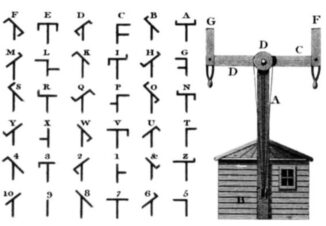
Claude Chappe named the telegraph method ‘semaphore’, from the Greek words for sign and carrying.
The actual codes were written in codebooks—with Chappe’s 1795 codebook containing 8,940 words and phrases. WATCH how it works… (1791)
93 years ago today, Mikhail Gorbachev was born. The world leader was most responsible for the end of the Cold War between Russians and Americans, and the dramatic reduction in nuclear weapons on the nuclear chessboard. 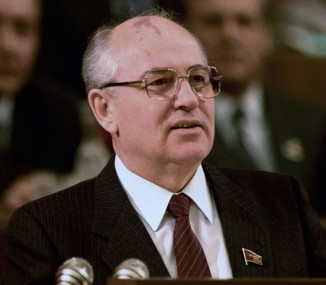 The last leader of the Soviet Union, his policy of Perestroika (restructuring) moved the nation toward democratic and capitalist principles–and inadvertently led to its dissolution and an end to communist party rule. He received the Nobel Peace Prize for introducing the policy of Glasnost, which called for increased openness and transparency in government and gave freedoms to the Soviet people, never previously experienced.
The last leader of the Soviet Union, his policy of Perestroika (restructuring) moved the nation toward democratic and capitalist principles–and inadvertently led to its dissolution and an end to communist party rule. He received the Nobel Peace Prize for introducing the policy of Glasnost, which called for increased openness and transparency in government and gave freedoms to the Soviet people, never previously experienced.
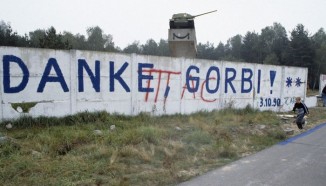
His negotiations with President Reagan over strategic nuclear arms led to a lifelong friendship. He was responsible for “tearing down” the Berlin Wall separating East and West Germany. Read more about one of the most pivotal progressive figures of the 20th century in his memoirs. (1931)
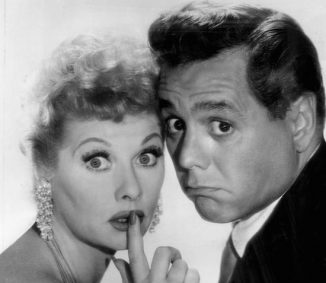 107 years ago, actor and producer Desi Arnaz was born in Cuba. Also a musician, writer and director, he is best remembered for his role as Ricky Ricardo on the American TV sitcom I Love Lucy, starring his wife Lucille Ball, but he was a true groundbreaker.
107 years ago, actor and producer Desi Arnaz was born in Cuba. Also a musician, writer and director, he is best remembered for his role as Ricky Ricardo on the American TV sitcom I Love Lucy, starring his wife Lucille Ball, but he was a true groundbreaker.
With Ball, Arnaz founded Desilu Productions, an empire that went on to produce The Andy Griffith Show, The Dick Van Dyke Show, The Lucy Show, Mission: Impossible, and Star Trek and is credited with the development of the live audience multi-camera production style which became the standard for subsequent sitcoms. Arnaz, who was one of the smartest businessmen in Hollywood, is also credited with Ball as inventing the rerun, which earned them residual income from I Love Lucy. Arnaz also pushed the CBS network to allow them to show Ball pregnant, after getting a rabbi, priest and minister to say there was nothing wrong with it. The Latin bandleader who toured worldwide with his band, the Desi Arnaz Orchestra, died at 69 of lung cancer. (1917)
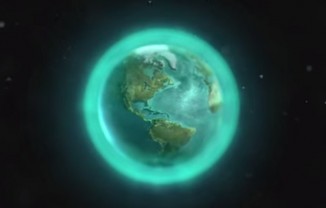
Also, 35 years ago today, in response to a dramatic depletion of Earth’s ozone layer, twelve European nations agreed to ban the production of all chlorofluorocarbons (CFCs) by the end of the century. A volatile derivative of methane, ethane, and propane, CFCs have since been completely phased out worldwide, after world diplomats forged a treaty—the Montreal Protocols—which called for drastic reductions of the chemicals. Today, the ozone hole is healing and significantly smaller than decades ago.
From 2000 to 2013, ozone levels were restored by 4 percent—and in some areas of the world, they could be completely healed as early as 2030. “It’s a victory for diplomacy and for science,” and for the fact that all the nations in the world worked together, said the Nobel Prize chemist who first forecasted the atmosphere’s ozone depletion in 1974. A true international success story, 197 nations signed the Ozone Treaty agreements, making the Montreal Protocols the first to be unanimously adopted by all members of the United Nations. (1989)

Happy Birthday to English actor Daniel Craig who turns 56 today. He became the sixth–and most popular–James Bond, first taking on the role of our favorite secret agent in Casino Royale. The film had the best box-office receipts for any Bond film to date. Craig’s third film in the series, Skyfall, premiered in 2012 and is not only the highest-grossing Bond flick, but the 15th highest-grossing movie of all time.
His first notable films included the action film Lara Croft: Tomb Raider, the crime thriller Road to Perdition, and the Steven Spielberg historical drama Munich. Since taking the role of Bond, he has continued to star in other films, including the fantasy film The Golden Compass, the World War II flick Defiance, a 2011 sci-fi western co-starring Harrison Ford and directed by Jon Favreau called Cowboys & Aliens, the mystery thriller and The Girl with the Dragon Tattoo. See all his films on Amazon. (1968)
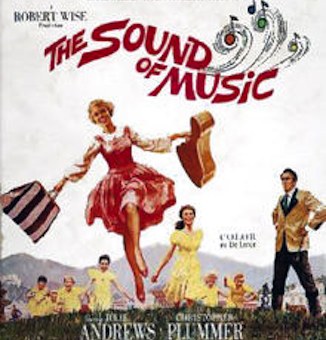
And, 59 years ago today, The Sound of Music premiered in movie theaters, featuring the incredible singing performance of 28-year-old Julie Andrews as the spunky nanny who goes to work for the von Trapp family in Austria. The patriarch disciplinarian played by Christopher Plummer places the guitar-playing nun in charge of his seven lonely children.
The music by Rodgers and Hammerstein contains some of the most memorable songs of stage and screen, including Edelweiss, My Favorite Things, and Do-Re-Mi. Based on the memoir The Story of the Trapp Family Singers by Maria von Trapp, the film became one of the highest-grossing films of all time, grossing $286 billion dollars worldwide after several re-releases, and won five Academy Awards, including Best Picture. (1965)
SHARE the Milestones, Memories, and Music…





















[…] The Good News Network […]
[…] post Good News in History, March 2 appeared first on The Good News […]